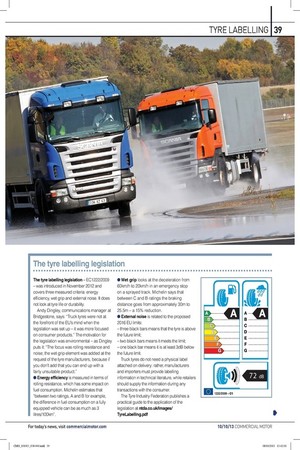The tyre labelling legislation
Page 33

If you've noticed an error in this article please click here to report it so we can fix it.
The tyre labelling legislation — EC1222/2009 —was introduced in November 2012 and covers three measured criteria: energy efficiency, wet grip and external noise. It does not look at tyre life or durability.
Andy Dingley, communications manager at Bridgestone, says: "Truck tyres were not at the forefront of the EU's mind when the legislation was set up — it was more focused on consumer products." The motivation for the legislation was environmental — as Dingley puts it: "The focus was rolling resistance and noise; the wet grip element was added at the request of the tyre manufacturers, because if you don't add that you can end up with a fairly unsuitable product."
• Energy efficiency is measured in terms of rolling resistance, which has some impact on fuel consumption. Michelin estimates that "between two ratings, A and B for example, the difference in fuel consumption on a fully equipped vehicle can be as much as 3 litres/100km".
• Wet grip looks at the deceleration from 60km/h to 20km/h in an emergency stop on a sprayed track. Michelin says that between C and B ratings the braking distance goes from approximately 30m to 25.5m — a 15% reduction. • External noise is related to the proposed 2016 EU limits: — three black bars means that the tyre is above the future limit; — two black bars means it meets the limit;
— one black bar means it is at least 3dB below the future limit.
Truck tyres do not need a physical label attached on delivery: rather, manufacturers and importers must provide labelling information in technical literature, while retailers should supply the information during any transactions with the consumer. The Tyre Industry Federation publishes a practical guide to the application of the legislation at ntda.co.uWimages/ TyreLabelling.pdf









































